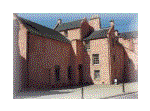|
Notes
The Rev.
James Pitcairn, LL.B., 20th laird, and last owner of the Barony of
Forthar in the direct line, was born in 1715.
He was Prebendary of Exeter Cathedral, Rector of Compton
Bassett and West Kington. The
only son of David Pitcairn of Forthar, and Agnes Douglas his wife,
he was educated at the Glasgow University and matriculated there:
the entry says, “F. Davidis Pitcairn de Forthar in Comit.
Fifense, matric. Alb.1733.”
His
father, David died two years after James left Oxford.
James then succeeded to the family estates.
In the Indices of the Retours (General Index, 28) James
Pitcairn of Forthar is mentioned as being served heir to his
father David Pitcairn of Forthar, who died 3rd June
1739. Heir special in
the lands, Barony and Manor-place of Forthar, in the Parish of
Kettle, Fifeshire, dated 25th September and recorded
October 1740. (Also No.32) James Pitcairn, Clergyman at Cloon, Longfoord, in Ireland,
only son of David Pitcairn, late of Forthar, brother-german of
Marion Pitcairn, to his aunt the said Marion Pitcairn, wife of
William Bawen of Kinnittles, heir in general, dated 10th
and recorded 17th January 1759.
The Rev
James Pitcairn therefore was declared heir to Forthar; but the
Pitcairns were ardent Jacobites, their estates of Forfar and Dovan
were probably forfeited in 1745, as Pitcairn was in 1715. The estate had to be sold on the 23rd Feb. 1756,
when it passed into the hands of Dr Stewart Thriepland, who
evidently bought it back for Dr William Pitcairn.
James
Pitcairn of Forthar succeeded, therefore, to many difficulties and much embarrassment, which is easily
understood, for, if his father were heavily fined for his opinions
and Jacobite leanings, so that the estate had to be sold in1756,
David must have left little spare cash for his son and heir.
James left Oxford in 1737, and before 1749 he had left
Scotland for ever. He
went to Ireland, and was appointed rector of Cloon near Longford.
He wrote from there to his great friend, a Dr Middleton,
who it appears helped him in his difficulties.
They are pathetic letters, and wonderfully cheerful,
considering he had lost his patrimony, was exiled from his old
home, and much hampered by small debts, which were a great trouble
to him. However,
brighter times were in store for him, and in 1759 he was appointed
to the livings of Compton Bassett and West Kington, in Wiltshire,
and his hard struggles were then over.
Later on he was made Prebendary of Exeter.
Prebendary
Pitcairn was a good, sincere, and kind-hearted m an, who had had
to submit to the loss of worldly goods of many kinds, but was not
embittered by it, and evidently tried to do his duty by his parish
and his family. He
was a true friend, and an affectionate husband and father
He
married Elizabeth, daughter of Sir------ Axford, a Gloucestershire
baronet. After he
went to live at Compton Bassett, he was made Prebendary of Exeter
Cathedral. The
Pitcairns had ten children.
Elizabeth
Pitcairn, wife of the Rev. James Pitcairn, then Rector of this
Parish was buried in the Chancel about three feet distant from the
North Wall.
|


